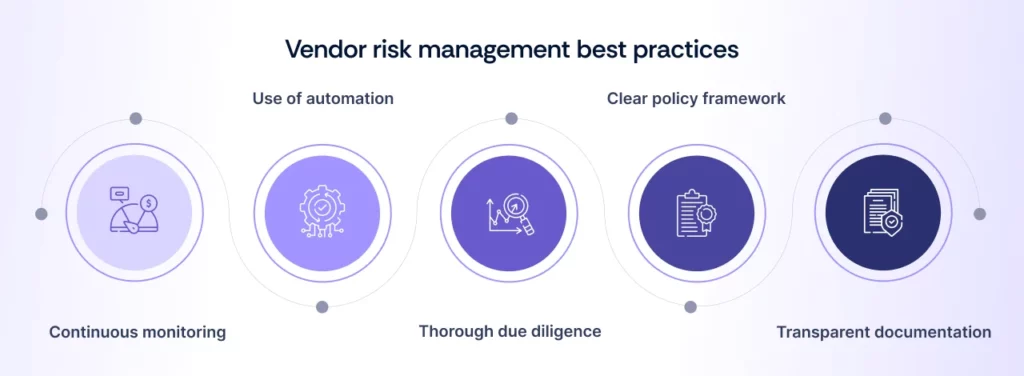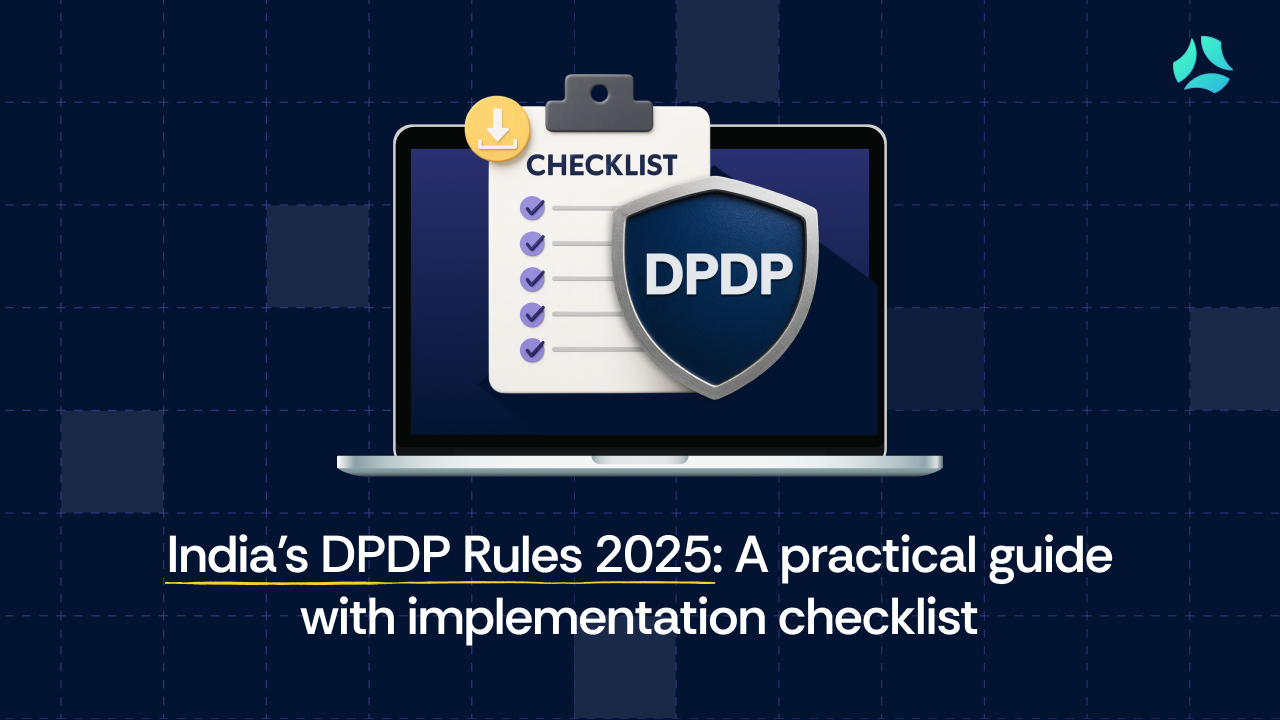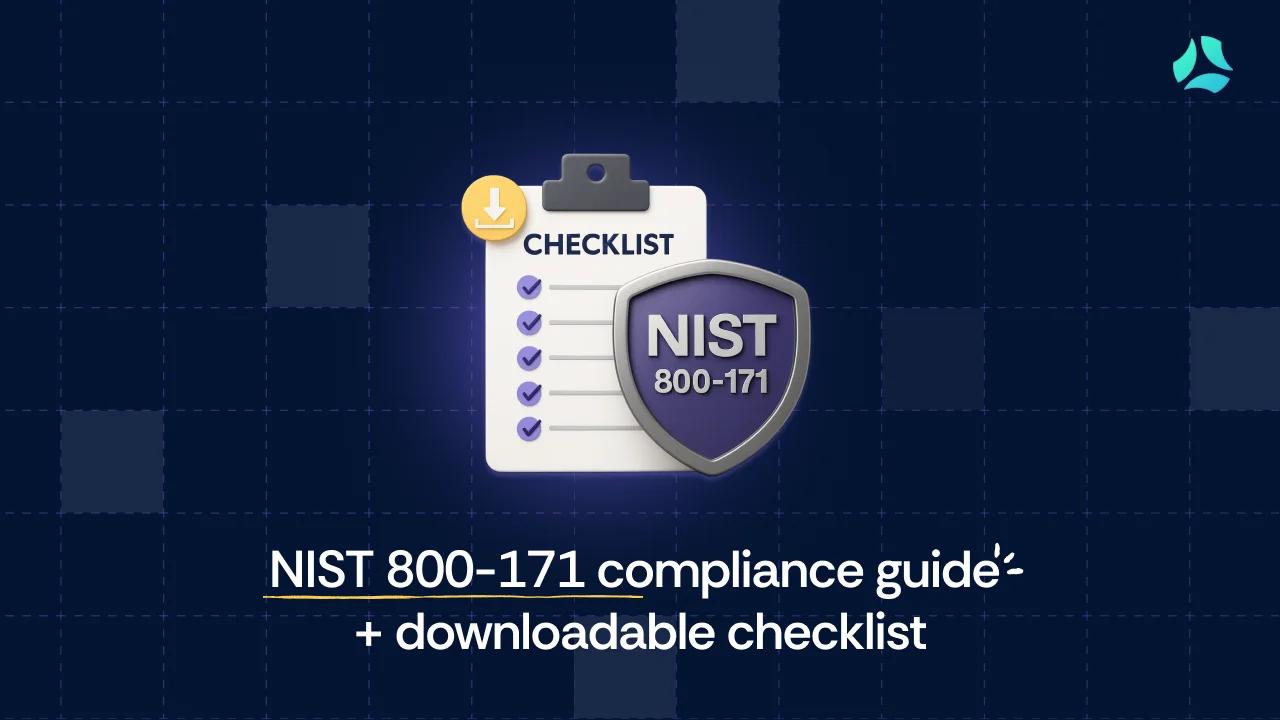Comprehensive Guide to Vendor Risk Management

Your organization might have solid security controls in place, but what about your vendors? Every third-party tool, service, or partner you rely on creates an entry point you don’t fully control. And with nearly 1 in 3 breaches now involving third parties, overlooking vendor risk isn’t an option.
This guide shows how a strong vendor risk management program helps you stay secure, proactive, and out of the headlines for the wrong reasons.
What is vendor risk management?
Vendor Risk Management (VRM) is the process of spotting, assessing, and tackling risks from third-party vendors—think software providers, cloud services, or suppliers. It’s about ensuring these partners don’t jeopardize your operations, security, or compliance.
VRM is critical as businesses lean on outsourcing. A strong VRM program shields you from data breaches, regulatory fines, and disruptions, keeping your reputation intact and your business humming.
Why is vendor risk management important?
Vendors can make or break your business. A single oversight can lead to massive financial losses from breaches or downtime. Regulatory non-compliance risks hefty fines and legal trouble, especially under strict rules like GDPR or HIPAA. Reputational damage from a vendor’s misstep can erode customer trust, driving away business.
VRM is your safeguard, ensuring vendors meet security and compliance standards, minimizing disruptions, and protecting your bottom line, brand, and peace of mind.
Types of vendor risks to monitor
Vendors bring a range of risks that can disrupt your business, from security lapses to regulatory missteps. Understanding these risks is the first step to managing them effectively. A strong VRM program monitors these key areas to keep your operations secure and compliant.
1. Third-party compliance and regulatory risk
Compliance and regulatory risk arises when vendors fail to follow legal or industry standards, exposing your business to penalties or legal trouble. You identify it by reviewing vendor contracts and audit reports to ensure alignment with regulations like GDPR or HIPAA.
To mitigate this risk, include strict compliance requirements in your vendor agreements—along with a clear right to audit clause—and conduct regular audits to confirm adherence. These steps help keep your business on the right side of the law.
2. Third-party cybersecurity risk
Third-party cybersecurity risk stems from vulnerabilities in a vendor’s digital defenses that could lead to data breaches or system compromises. You spot it by assessing their cybersecurity policies, patch management, incident response plans, and more.
Vendor security questionnaires are a practical way to uncover these details—covering everything from vulnerability scans and certifications to risk management practices.
To mitigate this risk, require vendors to follow robust security frameworks like NIST CSF, and conduct ongoing assessments to ensure their defenses remain strong and your data stays protected.
3. Third-party information security risk
Information security risk involves the potential for vendors to mishandle or expose sensitive data entrusted to them. You detect it by mapping data flows and evaluating vendor access controls and data protection measures.
To mitigate, enforce encryption standards, restrict data access to only what’s needed, and require regular security training for vendor staff, ensuring your confidential information stays secure.
4. Environmental, social, and governance (ESG) risk
ESG risk emerges when vendors’ practices conflict with your environmental, social, or ethical standards, threatening your brand’s values. You identify it by assessing their sustainability policies, labor practices, and governance frameworks.
To mitigate, set clear ESG expectations during vendor selection and monitor compliance through periodic reviews, aligning partnerships with your commitment to responsible business practices.
5. Third-party operational risk
Operational risk occurs when vendor failures, like service outages or delays, disrupt your business processes. You spot it by reviewing vendor performance records and contingency plans. To mitigate, establish clear service-level agreements (SLAs) with defined performance standards and maintain backup vendors to ensure continuity, keeping your operations running smoothly despite vendor hiccups.
6. Third-party legal risk
Legal risk surfaces when vendors’ actions lead to lawsuits or contractual disputes that could impact your business. You identify it by examining vendor contracts for liability provisions and legal compliance. To mitigate, draft robust agreements with clear indemnification clauses and monitor vendor activities closely, reducing the chance of costly legal entanglements.
7. Third-party strategic risk
Strategic risk happens when a vendor’s priorities or performance don’t align with your business goals, hindering growth. You detect it by evaluating how well vendors support your strategic objectives during onboarding. To mitigate, select vendors whose goals match yours and regularly review their contributions to ensure they advance your business, not hold it back.
8. Third-party reputational risk
Reputational risk arises when a vendor’s actions harm your brand’s trust or public image. For example, in 2022, Okta faced backlash after a third-party vendor was breached, raising concerns about its security practices—even though the issue wasn’t directly caused by Okta itself.
You identify this kind of risk by monitoring vendor conduct and public perception through feedback channels and news alerts. To mitigate, enforce strict ethical and security standards in vendor contracts and address issues swiftly with transparent communication—protecting your reputation from damage caused by their missteps.
How to identify vendor risk
Identifying vendor risk is about uncovering weaknesses before they hit your business. A vendor management risk matrix is a powerful tool to map out risks across your third-party partnerships, assessing their likelihood and impact to prioritize action.
By reviewing vendor contracts, performance data, security policies, and compliance records, you can pinpoint vulnerabilities and address them proactively, ensuring your VRM program keeps your business secure and on track.
The vendor risk management process
The vendor risk management (VRM) process is a structured workflow to safeguard your business from third-party vulnerabilities. It involves a series of steps—identifying risks, analyzing their impact, planning responses, mitigating threats, and monitoring outcomes—to ensure vendors don’t disrupt operations or compliance. By following this process, you can proactively address risks and keep your business secure.
1. Risk identification
Risk identification is the first step in spotting potential threats from vendors that could harm your business. It involves reviewing vendor contracts, security policies, and operational practices to uncover weaknesses like compliance gaps or cybersecurity flaws. By thoroughly assessing vendor activities, you pinpoint risks before they escalate, setting the foundation for a robust VRM program.
2. Risk analysis
Risk analysis evaluates the severity and likelihood of identified vendor risks to prioritize action. You assess factors like data access, regulatory requirements, and operational dependencies to gauge potential impacts on your business. This step ensures you focus resources on the most critical threats, aligning your efforts with business goals and compliance needs.
3. Response planning
Response planning outlines how your business will address vendor risks when they materialize. This includes strategies for risk reduction—like incident response protocols—and risk transfer, such as having contractual agreements or cyber insurance in place.
Contingency plans, like lining up backup vendors, help minimize operational disruptions. By preparing tailored responses, your business can act quickly to contain vendor-related issues and maintain continuity.
4. Risk mitigation
Risk mitigation involves taking concrete actions to reduce vendor risks to a level your organization is willing to tolerate—also known as risk acceptance. This includes enforcing stricter contract terms, implementing security controls, or limiting vendor access to sensitive data. By proactively addressing gaps, you minimize threats and ensure vendors align with your security and compliance standards—without compromising business continuity.
5. Risk monitoring
Risk monitoring tracks vendor performance and risks over time to ensure the controls remain effective and to catch new threats early. By regularly reviewing vendor activities, audit reports, and security updates, you ensure ongoing compliance and resilience. This continuous oversight keeps your VRM program dynamic, adapting to evolving risks and protecting your business long-term.
6. Risk management automation
Risk management automation streamlines the VRM process by leveraging tools to handle repetitive tasks. Software can assess vendor risks, track compliance, and generate reports, saving time and reducing errors. By automating workflows, you boost efficiency, ensuring your VRM program stays proactive and scalable as your vendor network grows.
What makes a vendor risk management program a success?

A successful vendor risk management program hinges on clear policies, proactive oversight, and cross-team collaboration to keep risks in check. It thrives by embedding risk assessments into vendor onboarding, ensuring continuous monitoring of vendor performance, and aligning with business goals and compliance requirements. By fostering accountability and leveraging tools to streamline processes, your VRM program protects your business from disruptions, secures sensitive data, and builds trust with stakeholders.
Top vendor risk management software
Selecting the right vendor risk management (VRM) software is critical to keeping third-party risks in check while staying compliant and efficient. Scrut stands out for startups and mid-sized businesses, with other leading platforms offering robust solutions for diverse needs. Here’s a look at the top VRM software to protect your business and streamline vendor oversight.
1. Scrut Automation
Scrut delivers a powerful VRM platform tailored for fast-growing companies that need to manage vendor risks without sprawling teams. Its AI-driven automation simplifies risk assessments, compliance tracking, and real-time monitoring, ensuring your business stays audit-ready across multiple frameworks.
With intuitive tools and seamless integrations, Scrut keeps vendor risks under control, saving time and safeguarding your operations. Key features: Over 1400 pre-mapped controls for SOC 2, ISO 27001, GDPR, and more; 80+ integrations for automated evidence collection; centralized dashboard for tracking risks and compliance; and built-in analytics for audit-ready reports.
2. UpGuard
UpGuard provides robust VRM with real-time security ratings and fourth-party risk tracking, ideal for enterprises managing complex vendor networks and needing compliance with HIPAA or NIST CSF.
3. Sprinto
Sprinto streamlines VRM with automated risk assessments and continuous compliance monitoring, perfect for mid-market firms seeking seamless cloud integrations and multi-framework support.
4. Vanta
Vanta accelerates VRM with AI-powered vendor reviews and compliance automation, suited for businesses prioritizing rapid onboarding and adherence to GDPR or SOC 2.
5. Venminder
Venminder excels in VRM for regulated industries, offering automated risk assessments and contract management to ensure compliance with strict financial or legal standards.
Why choose Scrut for vendor risk management
Vendor risks can derail your business, but Scrut keeps your complex vendor ecosystem secure and compliant. Its AI-driven automation, centralized dashboard, and pre-mapped controls for SOC 2, GDPR, and more simplify risk assessments and ensure seamless audit readiness.
With robust integrations and real-time alerts, Scrut empowers you to manage vendors confidently, safeguarding operations and compliance. Choose Scrut to streamline your VRM program and protect your business from third-party threats.

FAQs
Who is considered a vendor for a risk management system?
A vendor is any third-party providing goods or services, including IT suppliers, service providers, or contractors handling sensitive data or critical operations.
Who are some high-risk vendors?
High-risk vendors handle sensitive data (e.g., PII), provide critical services (e.g., cloud providers), or have extensive system access (e.g., EMR vendors).
What are important vendor risk assessment questions?
Key questions include: What security controls are in place? How is data protected? Are compliance certifications current? See our vendor risk assessment guide for a full list.
What is the vendor risk management lifecycle?
The VRM lifecycle includes due diligence, onboarding, continuous monitoring, and offboarding to manage risks throughout the vendor relationship.
Does the vendor management program overlook vendor risk?
No, a robust Vendor Management Program integrates risk management to ensure oversight of vendor risks.
What are key risk indicators for vendor management?
KRIs include vendor uptime, security incident frequency, compliance status, and financial stability.
Does a vendor management framework help efficiently manage risk?
Yes, a structured vendor management framework streamlines risk identification, assessment, and mitigation.
Is vendor risk management important for all businesses?
VRM is critical for small, medium, and enterprise businesses to protect against disruptions, ensure compliance, and safeguard reputation, regardless of size.
What is a quick way to evaluate a third party’s security?
Use security ratings platforms for objective, non-invasive scans of a vendor’s external IT ecosystem.
Is vendor and supplier risk management the same?
No, vendor risk management focuses on service providers, while supplier risk management includes raw material providers. Learn more about SCRM, TPRM, and VRM differences.


















